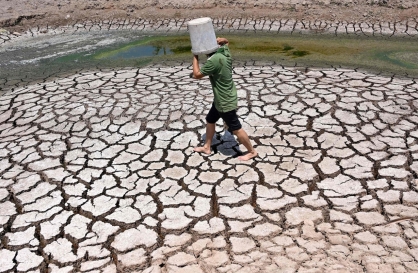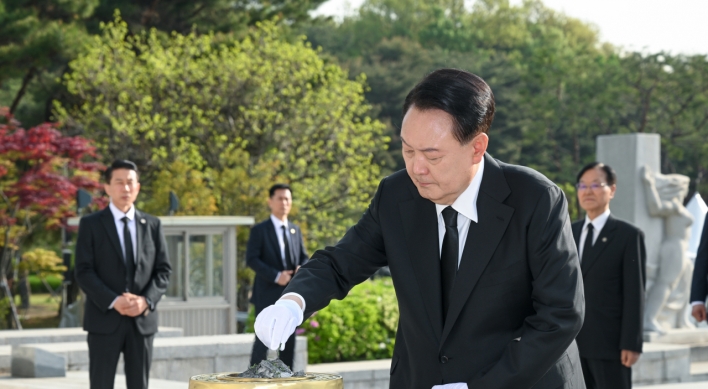JAKARTA ― The Association of Southeast Asian Nations stands at a defining moment. Its member states are constantly being evaluated for their economic potential and desirability as a market for investments, goods, and services. At the same time, their effort to forge a community free from external intervention is shaping a new regional order based on common security and shared prosperity.

In geopolitical terms, ASEAN is well-placed to be an acceptable and equal partner to many larger, more powerful economies, such as China, India, Japan, Australia, and South Korea ― a part of the world that, for the first time, is leading a global recovery. ASEAN has also contributed to building one of the most dynamic economic-integration platforms in the world, and now acts as a de facto regional hub of wider economic cooperation and integration.
Indeed, the importance of regional economic integration for global stability and security cannot be understated. The combined annual GDP of China, Japan, India, and ASEAN is $14.45 trillion, roughly equal to that of the United States, at $14.62 trillion. More importantly, East Asia’s economies are expected to grow at an average annual rate of 5.1 percent, compared to 3.2 percent in the U.S.
That said, the wide disparities and development gaps between ASEAN members call for a multi-track and multi-speed approach to deepening economic integration. In anticipation of worsening food and energy security concerns in the future, ASEAN has set priorities for programs that increase productivity and production, strengthen policy coordination on agricultural trade, and boost efforts to alleviate poverty.
East Asia needs to maintain a fine balance of political-security requirements in much the same way. Continual restructuring and consolidation will be needed to create a balanced regional geopolitical architecture, which must broaden beyond ASEAN members to meet the needs of Japan, the U.S., Australia, India, China, and Russia ― all of which have vital interests in the region. ASEAN pursues an inclusive growth strategy.
With the participation of the U.S. and Russia in the expanded East Asia Summit, the regional architecture is, indeed, becoming more dynamic. Given this, it is imperative that ASEAN becomes proactive and remains focused on relevant strategic issues. In engaging the major powers, ASEAN will not shun traditional security issues, such as maritime cooperation, as well as humanitarian assistance and disaster relief.
Japan has been the biggest provider of development assistance and technological know-how to ASEAN for the past four decades. Indeed, Japan’s investment and aid to Southeast Asia have fueled ASEAN’s economic progress. I believe that Japan’s strategic role in the region will only increase, because its economy and industrial production chains have been regionally integrated. Both sides have pledged to forge closer cooperation and initiate new programs to consolidate their relationship.
Nevertheless, unresolved and overlapping maritime and territorial claims remain ASEAN’s biggest challenge. We believe that maritime cooperation between ASEAN and major powers including China would benefit all countries. ASEAN will continue to address this issue strategically.
And, as to Myanmar, ASEAN has deferred the decision on its prospective chairmanship in 2014. At its recent summit, ASEAN leaders asked Myanmar for more clarification about the country’s internal situation. In doing so, ASEAN showed its continued influence on Myanmar’s progress towards democratic reforms.
Not all challenges, however, are external. The critical issue concerns ASEAN’s engagement with civil society. Indonesia’s government has expressed support for more proactive engagement with the region’s civil-society organizations, pledging to organize “community conferences or forums” to engage with stakeholders in efforts to strengthen the security, economic, and sociocultural pillars that support ASEAN as a group. Indonesia hopes that these community conferences will gradually gain acceptance at the ASEAN level.
Through these efforts, ASEAN is emerging as the fulcrum of geopolitical stability in Asia. What could have otherwise been a liability ― ASEAN’s diversity ― was transformed into an asset that has set the benchmark for regional integration in a troubled and complex world. Yes, we have our share of challenges. Nevertheless, ASEAN is constantly demonstrating its determination to create a region where no member is left behind, even as we collectively pursue prosperity and an equitable distribution of our burgeoning wealth.
Moreover, ASEAN is seeking to forge a clearer position on key international issues to heighten its standing on world affairs. Disaster management, peace-keeping operations, and, again, maritime-security cooperation are some of the areas in which ASEAN members can work together to formulate common policy approaches and action plans. In the years to come, ASEAN will make further progress on unified responses to climate change, human trafficking, and food and energy security.
Of course, as it moves forward, ASEAN will have to make structural and policy adjustments to strengthen its voice. And the ability to deter and resolve conflicts among its members must remain one of its priorities. At its recent summit, ASEAN agreed to establish an ASEAN Institute for Peace and Reconciliation that will deal with issues of peace and reconciliation ― a milestone achievement for ASEAN.
There will be many more innovative breakthroughs as ASEAN develops into an integrated, open, peaceful, and outward-looking region. That outcome will benefit ASEAN’s members ― and the world.
By Surin Pitsuwan
Surin Pitsuwan is secretary-general of ASEAN. ― Ed.
(Project Syndicate/Asia Society)

In geopolitical terms, ASEAN is well-placed to be an acceptable and equal partner to many larger, more powerful economies, such as China, India, Japan, Australia, and South Korea ― a part of the world that, for the first time, is leading a global recovery. ASEAN has also contributed to building one of the most dynamic economic-integration platforms in the world, and now acts as a de facto regional hub of wider economic cooperation and integration.
Indeed, the importance of regional economic integration for global stability and security cannot be understated. The combined annual GDP of China, Japan, India, and ASEAN is $14.45 trillion, roughly equal to that of the United States, at $14.62 trillion. More importantly, East Asia’s economies are expected to grow at an average annual rate of 5.1 percent, compared to 3.2 percent in the U.S.
That said, the wide disparities and development gaps between ASEAN members call for a multi-track and multi-speed approach to deepening economic integration. In anticipation of worsening food and energy security concerns in the future, ASEAN has set priorities for programs that increase productivity and production, strengthen policy coordination on agricultural trade, and boost efforts to alleviate poverty.
East Asia needs to maintain a fine balance of political-security requirements in much the same way. Continual restructuring and consolidation will be needed to create a balanced regional geopolitical architecture, which must broaden beyond ASEAN members to meet the needs of Japan, the U.S., Australia, India, China, and Russia ― all of which have vital interests in the region. ASEAN pursues an inclusive growth strategy.
With the participation of the U.S. and Russia in the expanded East Asia Summit, the regional architecture is, indeed, becoming more dynamic. Given this, it is imperative that ASEAN becomes proactive and remains focused on relevant strategic issues. In engaging the major powers, ASEAN will not shun traditional security issues, such as maritime cooperation, as well as humanitarian assistance and disaster relief.
Japan has been the biggest provider of development assistance and technological know-how to ASEAN for the past four decades. Indeed, Japan’s investment and aid to Southeast Asia have fueled ASEAN’s economic progress. I believe that Japan’s strategic role in the region will only increase, because its economy and industrial production chains have been regionally integrated. Both sides have pledged to forge closer cooperation and initiate new programs to consolidate their relationship.
Nevertheless, unresolved and overlapping maritime and territorial claims remain ASEAN’s biggest challenge. We believe that maritime cooperation between ASEAN and major powers including China would benefit all countries. ASEAN will continue to address this issue strategically.
And, as to Myanmar, ASEAN has deferred the decision on its prospective chairmanship in 2014. At its recent summit, ASEAN leaders asked Myanmar for more clarification about the country’s internal situation. In doing so, ASEAN showed its continued influence on Myanmar’s progress towards democratic reforms.
Not all challenges, however, are external. The critical issue concerns ASEAN’s engagement with civil society. Indonesia’s government has expressed support for more proactive engagement with the region’s civil-society organizations, pledging to organize “community conferences or forums” to engage with stakeholders in efforts to strengthen the security, economic, and sociocultural pillars that support ASEAN as a group. Indonesia hopes that these community conferences will gradually gain acceptance at the ASEAN level.
Through these efforts, ASEAN is emerging as the fulcrum of geopolitical stability in Asia. What could have otherwise been a liability ― ASEAN’s diversity ― was transformed into an asset that has set the benchmark for regional integration in a troubled and complex world. Yes, we have our share of challenges. Nevertheless, ASEAN is constantly demonstrating its determination to create a region where no member is left behind, even as we collectively pursue prosperity and an equitable distribution of our burgeoning wealth.
Moreover, ASEAN is seeking to forge a clearer position on key international issues to heighten its standing on world affairs. Disaster management, peace-keeping operations, and, again, maritime-security cooperation are some of the areas in which ASEAN members can work together to formulate common policy approaches and action plans. In the years to come, ASEAN will make further progress on unified responses to climate change, human trafficking, and food and energy security.
Of course, as it moves forward, ASEAN will have to make structural and policy adjustments to strengthen its voice. And the ability to deter and resolve conflicts among its members must remain one of its priorities. At its recent summit, ASEAN agreed to establish an ASEAN Institute for Peace and Reconciliation that will deal with issues of peace and reconciliation ― a milestone achievement for ASEAN.
There will be many more innovative breakthroughs as ASEAN develops into an integrated, open, peaceful, and outward-looking region. That outcome will benefit ASEAN’s members ― and the world.
By Surin Pitsuwan
Surin Pitsuwan is secretary-general of ASEAN. ― Ed.
(Project Syndicate/Asia Society)








![[Graphic News] More Koreans say they plan long-distance trips this year](http://res.heraldm.com/phpwas/restmb_idxmake.php?idx=644&simg=/content/image/2024/04/17/20240417050828_0.gif&u=)
![[KH Explains] Hyundai's full hybrid edge to pay off amid slow transition to pure EVs](http://res.heraldm.com/phpwas/restmb_idxmake.php?idx=644&simg=/content/image/2024/04/18/20240418050645_0.jpg&u=20240419100350)





![[From the Scene] Monks, Buddhists hail return of remains of Buddhas](http://res.heraldm.com/phpwas/restmb_idxmake.php?idx=652&simg=/content/image/2024/04/19/20240419050617_0.jpg&u=20240419175937)

![[KH Explains] Hyundai's full hybrid edge to pay off amid slow transition to pure EVs](http://res.heraldm.com/phpwas/restmb_idxmake.php?idx=652&simg=/content/image/2024/04/18/20240418050645_0.jpg&u=20240419100350)

![[Today’s K-pop] Illit drops debut single remix](http://res.heraldm.com/phpwas/restmb_idxmake.php?idx=642&simg=/content/image/2024/04/19/20240419050612_0.jpg&u=)